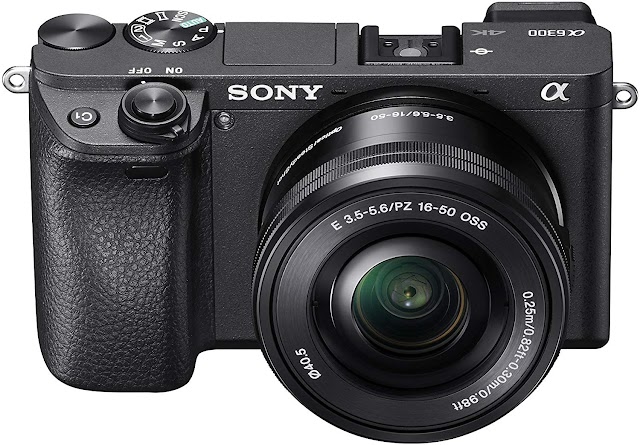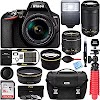At the end of April 2018, Nikon became one of the well-known camera brands that are being widely discussed. Because, they officially introduced the D3500 as one of their best DSLR cameras in the entry-level market.
Basically, this is the next generation of the D3400 which is experiencing a significant update. This time, Nikon carries the latest sensors, the 24.2 megapixel DX-CMOS sensor combined with the EXPEED 4 image processor.
The camera has an ISO 100-25600 range, an 11-point autofocus system and can shoot continuously at 5 fps. There is no 4K video feature, but the D3500 can record video with 1080p resolution at 60fps. Considering this is an entry-level camera, it certainly is perfect if you are looking for the best and cheapest DSLR camera.
Broadly speaking, the D3500 does have a lot in common with its predecessor, but there are some important differences that you can feel. Like the redesigned front handle. In particular, the D3500 has moved the top "info" button to the back. Nikon also added the Live View lever around the mode button, not the button behind the D3400.
In the specifications of a good camera this experience many changes, especially on the back. Nikon has moved the 5 buttons that were previously on the D3400 except the flash button to the right of the viewfinder and LCD.
There is an "info" button that is moved to the right of the viewfinder, along with AE-L / AF-L, playback, menus and delete buttons. Regarding the viewfinder and rear view, the viewfinder offers around 95 percent horizontal and vertical frame coverage.
The viewfinder magnification is approximately 0.85x, which is about 0.57x in 35mm. The rear screen is a 3-inch LCD with 921,000 dots and a 170 degree viewing angle. Unfortunately, the LCD has not been accompanied by a touchscreen feature. On the dimensions, the D3500 is smaller than the D3500 with details of 4.9 inches (124 mm), 3.8 inches high (97mm) and has a maximum depth of 2.7 inches (69.5 mm).
As one of the best Nikon cameras, the D3500 is equipped with a DX (APS-C) CMOS image sensor with 24.2 megapixels and a new EXPEED 4 image processing machine. The combination of this technology makes the camera capable of shooting continuously up to 5 fps.
Regarding auto focus, the D3500 uses an 11-point autofocus phase-detection system (1 cross-type). The camera also provides a spot AF mode that offers AF-S, AF-C and AF-A drive modes. The autofocus detection range is -1 to 19 EV.
In the D3500 Live View mode using contrast detection, you can choose the automatic focal point of the entire frame. The camera also offers face detection functions and subject tracking. There is something interesting about the Nikon D3500 specification, which is the D3500 User Guide feature.
This feature is useful for those of you who want to learn about shooting modes such as priority openings, shutter speed priority and manual mode, or how to take photos of certain subjects. It's natural to be the best camera. Then, there are also scene modes that you can use such as Automatic, Automatic (flash off), close-up, night portraits, portraits, sports and special effects modes.
The D3500 has a built-in flash in addition to the hot shoe, and Creative Lighting System (CLS) from Nikon. Like its predecessor, the camera has a maximum flash sync speed of 1/200s. Flash compensation can be adjusted from -3 to +1 EV with the addition of 1/3 EV.
 |
| Photograph of Nikon D3500 DSLR Camera |
Flash pop-ups have a Guide Number 7 meters or 22 feet at ISO 100 in auto TTL mode, or 8m / 26 feet manual flash mode. Although the D3500 does not offer 4K UHD video recording, the camera is capable of recording Full HD resolution (1920 x 1080).
 |
| Photograph of Nikon D3500 DSLR Camera |
The camera can record 1080p video up to 60 fps. When shooting with normal quality, you can record up to 29 minutes 59 seconds. At the highest quality, the maximum clip length is 20 minutes. Note D3500 in the .MOV format using H.264 / MPEG-4 video compression.
Don't forget the camera has a built-in microphone and monaural speaker but does not have audio input or output. On the plus side, the D3500 is equipped with the latest AF-P zoom lens from Nikon, which offers improved autofocus performance during video recording.
For durability, the D3500 uses a lithium-ion EN-EL14a battery. The battery has a CIPA value for shooting 1,550 per charge. Storage is provided through SD / SDHC / SDXC card slots with support for UHS-I and Eye-Fi types.
As a complement, the D3500 has a built-in Bluetooth 4.1 that works with Nikon SnapBridge, Nikon's smartphone connectivity system. You can transfer the photos of Nikon D3500 to a smartphone with the application and you can also control the camera remotely. Not to forget the High-speed USB 2.0 Micro-B port and the Mini HDMI Type-C terminal are also included.
The D3500 is Nikon's newest DSLR camera in the entry-level market. Of course the specifications carried are also not too high and not too low. But if you are looking for a camera with speed and usage that is not complicated, the D3500 can be the solution.
Full Specifications of Nikon D3500
| General | |
|---|---|
| Brand | Nikon |
| Model | Nikon D3500 |
| Announced | 2018-08-29 |
| Body Type | Compact SLR |
| Lens | |
| Manual Focus | |
| Lens Mount | Nikon F |
| Number of Lenses | 302 |
| Focal Length Multiplier | 1.5x |
| Macro Focus Range | n/a |
| Screen | |
| Screen Type | Fixed Type |
| Screen Technology | TFT LCD |
| Screen Size | 3" |
| Screen Resolution | 921k dots |
| Live View | |
| Touch Screen | |
| Viewfinder | |
| Viewfinder | Optical (pentamirror) |
| Viewfinder Resolution | no electronic viewfinder |
| Viewfinder Coverage | 95% |
| Viewfinder Magnification | 0.56 |
| Photography Features | |
| Min Shutter Speed | 30s |
| Max Shutter Speed | 1/4000s |
| Continuous Shooting | 5.0 fps |
| Shutter Priority | |
| Aperture Priority | |
| Manual Exposure Mode | |
| Exposure Compensation | Yes |
| Custom White Balance | |
| Image Stabilization | |
| Built-in Flash | |
| Flash Range | 7.00 m (at ISO 100) |
| Flash Modes | Auto, Auto slow sync, Auto slow sync with red-eye reduction, Auto with red-eye reduction, Fill-flash, Off, Rear-curtain sync, Rear-curtain with slow sync, Red-eye reduction, Red-eye reduction with slow sync, Slow sync |
| External Flash | |
| AE Bracketing | |
| WB Bracketing | |
| Exposure Modes | |
| Multi-Segment | |
| Average | |
| Spot | |
| Partial | |
| AF-Area | |
| Center Weighted | |
| DxO Sensor Scores | |
| DxO Overall Score | not tested |
| DxO Color Depth | not tested |
| DxO Dynamic Range | not tested |
| DxO Low Light ISO | not tested |
| Sensor | |
|---|---|
| Sensor Type | CMOS |
| Sensor Size | APS-C |
| Sensor Dimensions | 23.5 x 15.6 mm |
| Sensor Area | 366.60mm2 |
| Sensor Resolution | 24 megapixels |
| Max Image Resolution | 6000 x 4000 |
| Max Native ISO | 25,600 |
| Min Native ISO | 100 |
| RAW Support | |
| Autofocus | |
| AF Touch | |
| AF Continuous | |
| AF Single | |
| AF Tracking | |
| AF Selective | |
| AF Center | |
| AF Multi Area | |
| AF Live View | |
| AF Face Detection | |
| AF Contrast Detection | |
| AF Phase Detection | |
| Number of Focus Points | 11 |
| Number of Cross Focus Points | Unknown |
| Video Features | |
| Video Resolutions | 1920 x 1080 (60, 50, 30, 25, 24 fps), 1280 x 720 (60, 50 fps), 640 x 424 (30, 25 fps) |
| Max Video Resolution | 1920 x 1080 |
| Video Formats | MPEG-4, H.264 |
| Microphone Port | |
| Headphone Port | |
| Connectivity | |
| Wireless Connectivity | No |
| HDMI | |
| USB | USB 2.0 (480 Mbit/sec) |
| Physical | |
| Environmental Sealing | |
| Water Proof | |
| Dust Proof | |
| Shock Proof | |
| Crush Proof | |
| Freeze Proof | |
| Weight | 365g |
| Physical Dimensions | 124 x 97 x 70mm |
| Battery Life | 1550 shots |
| Battery Type | Battery Pack |
| Battery Model | EN-EL14a |
| Other Features | |
| Self Timer | Yes (2, 5, 10, 20 secs (1-9 exposures)) |
| Timelapse Recording | |
| GPS | None |
| Storage Type | SD/SDHC/SDXC |
| Storage Slots | 1 |





0 Comments